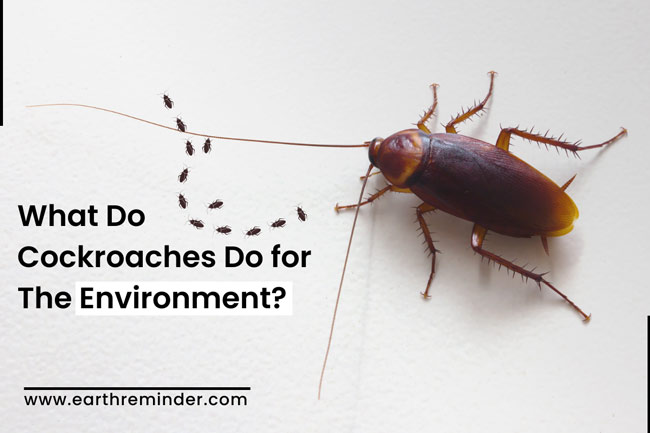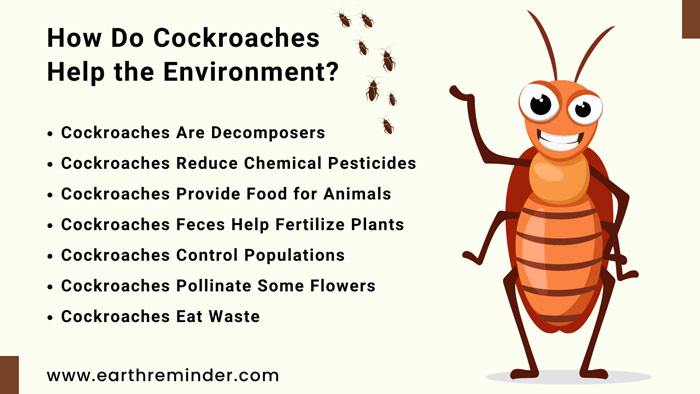What Do Cockroaches Do for The Environment?
Do you know what do cockroaches do for the environment? Here we will discuss everything about cockroaches, their habits, and what they do for your surroundings.
Table of Contents
Introduction to Cockroaches
Cockroaches are insects of the order Blattodea in the superorder Dictyoptera. There are about 4,500 species of cockroach, and most of them live in tropical regions, deserts, and woods.
If we go into more detail, The name cockroach comes from the Spanish word “Cucaracha.” They are among the world’s most primitive insects, which means that they are ancestors or relatives of all other bugs.
It’s helpful to know that cockroaches come in a variety of sizes and shapes. They have hard, thick outer shells called exoskeletons that cover their soft bodies. Their legs are long and thin, and they have antennae. They have two long threadlike feelers at the front of their heads and large eyes on top of their heads.
Cockroaches may be small, but they can squeeze into very small cracks in walls or furniture. They eat a lot of things like pet food or even paper, but it is not good for them to eat these things because it may make them sick.
It is a fact that they can run very fast! A cockroach is capable of running up to three miles per hour.
The most common cockroach sightings in homes are usually around toilets or in kitchens because these areas tend to be warm and humid with easy access to water.
Are Cockroaches Important to The Ecosystem?
The answer to this question depends on where you live in the world. In some places, cockroaches are unwanted pests that can lead to human health hazards, such as through the transmission of bacteria that cause disease.
For example, people with weak immune systems or chronic respiratory illnesses can contract asthma from cockroach droppings and bodies that have been crushed by human feet, though this is a rare occurrence.
In other places, however, cockroaches are part of an intricate/complex ecosystem vitally important to preserving the health of humans and animals. In these areas, cockroaches consume dead plant matter and return nutrients to the soil through their droppings.
If we look at the parts of Africa, Asia, and South America where cockroaches are common, farmers leave bowls of water with dead insects to attract them. These insects are then eaten by birds and rodents like rats, excreting their waste into the water again. The process continues until the nutrients are returned to the ground in a form that plants can absorb.
As there will be enough left over for animals and plants, we don’t need to worry about eliminating all insects from our planet as long as there is a balance between how many insects are attracted to farm fields and our homes.
It is widely believed by many scientists that losing biodiversity, or having too few species in any ecosystem, can be just as harmful to nature as losing an individual species.
How Do Cockroaches Help the Environment?
Fortunately, you will find that cockroaches are beneficial in many ways. They serve as a food source for many animals, including lizards and birds. The cockroach’s diet of decaying organic matter makes it a decomposer, helping to break down waste material into nutrients that plants can use to grow. Cockroaches also reduce the need for chemical pesticides because they feed on other insects that may harm humans or crops.
Cockroach feces contain nitrogen-rich proteins and amino acids, which help fertilize plants by releasing small amounts of fertilizer into the soil when they defecate (discharge feces from their body) near their food source (the dead insects).
This means that even though you may not want them around your home, or anywhere else, they can provide some benefits if left alone! If you want fewer cockroaches around but don’t want to use pesticides or kill them yourself with any methods, consider putting out bowls filled with water so the bugs stay hydrated instead of coming indoors during hot weather months when it’s too dry outside for them.
Now, we will discuss in detail what do cockroaches do for the environment.
Cockroaches Are Decomposers
Cockroaches are decomposers, which means they eat dead animals and plants. They help break down organic matter, an important part of the ecosystem, and can help prevent disease outbreaks.
Cockroaches have been found to be more effective than earthworms in turning over leaf litter (dead leaves) on forest floors. In comparison to earthworms, they have a higher surface-to-volume ratio, which allows them to eat through dense layers of decaying biomass more efficiently.
Cockroaches Reduce Chemical Pesticides
Cockroaches also play a role in reducing the need for chemical pesticides. They are one of the most efficient scavengers, with a diet that includes organic matter, dead animals, and other insects.
When there aren’t enough natural predators around to keep populations down naturally (like birds), cockroaches can act as an effective alternative for controlling pest numbers – especially when it comes to those bugs that cause damage to crops or spread disease both among humans and animals!
Cockroaches Provide Food for Animals
Cockroaches are a food source for many animals, including birds, fish, lizards, and other insects. They’re one of the most common sources of protein in some areas!
Cockroaches Feces Help Fertilize Plants
Cockroaches can help the environment by fertilizing plants. Feces in general are the waste product of insects. Plants need nitrogen, potassium, and phosphorus, all of which are found in feces. These minerals can be found in cockroach feces as well. Additionally, their feces contain vitamins and enzymes that are also beneficial to plants’ health.
Cockroaches Control Populations
Despite their bad reputation, cockroaches play an important role in keeping the ecosystem balanced. They are predators that eat other insects and arthropods like spiders and millipedes. They help control populations of other pests like mosquitoes, ants, and termites.
Cockroaches are natural predators of termites (wood-eating pests) and will eat them if they have access to them when they need an easy meal.
Likewise, cockroaches also make good food sources for local animals such as birds, frogs, and lizards. In this way, the ecosystem maintains balance among all.
Cockroaches Pollinate Some Flowers
You may be thinking, “No way! Cockroaches can’t help pollinate flowers! They’re unclean and unpleasant.” In a way, you are right. Cockroaches are not the best pollinators, but they can be attracted to light. They are usually not very good at it, but they do pollinate some flowers.
According to a study, A total of 11 plant species in the world have been reported to be pollinated by cockroaches.
Cockroaches Eat Waste
Cockroaches are scavengers, meaning they feed on decaying matter. That includes the feces of dogs and cats. We clean up pet waste often to keep our yards and homes free of pests. But if you see a cockroach in your yard or home, it’s a sign that you need to clean further all the waste properly.
Conclusion
Cockroaches are great for the environment. They clean up food scraps and water and provide nutrients for many other animals and insects. Cockroaches also control pest populations in areas where rodents live. They are vital to keeping our world (and us) healthy.
So, next time you’re grossed out by finding a few cockroaches, remember that they are performing an important service for you. After all, no one likes vermin infestation, but if you want to keep living in a safe and lead-free environment, something has to eat all that trash.
The purpose of a cockroach is clear. If you like this article, please share it with your friends. Also, comment down below for any queries.

